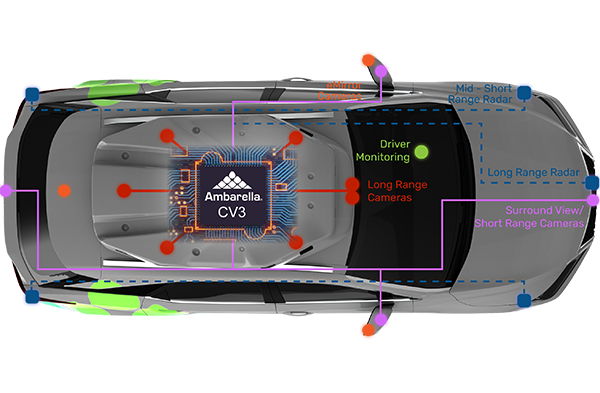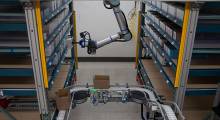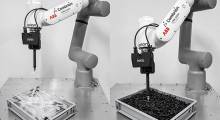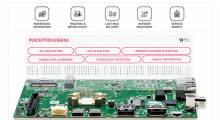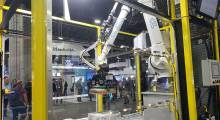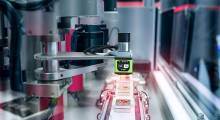Ambarella Inc. today announced during CES its CV3 domain controller family of artificial intelligence processors. The Santa Clara, Calif.-based AI silicon company said it enables centralized, single-chip processing for multi-sensor perception, as well as “deep fusion” for multiple sensor modalities and autonomous vehicle path planning.
“With our new CV3 AI domain controller family, we are now capable of running the full ADAS [advanced driver-assist systems] and AD [autonomous driving] stack with a single chip, while providing unprecedented performance and power efficiency,” said Fermi Wang, president and CEO of Ambarella.
“Through enhancements to our on-chip ISP [image signal processor], along with simultaneous radar processing that can take advantage of our Oculii adaptive AI algorithms, Ambarella is helping the automotive industry unlock greater levels of perception accuracy across all environmental conditions to realize the promise of autonomous driving,” he said.
Founded in 2004, Ambarella said its products are used in computer vision applications including security, ADAS, autonomous vehicles, and robotics. The company added that its systems on a chip (SoCs) offer compression, advanced image processing, and deep neural network processing to enable smart cameras to extract valuable data from high-resolution video streams.
Ambarella follows 'algorithm-first' philosophy
Ambarella said the CV3 marks the debut of its next-generation CVflow architecture, which continues its “algorithm-first” design philosophy. This drove the development of the on-chip neural vector processor (NVP), with up to 500 eTOPS (trillions of operations per second) of compute. The company claimed that it provides the automotive industry's highest AI processing performance, with a 42x increase over its prior automotive family.
Featuring up to 16 Arm Cortex-A78AE CPU cores, the CV3 can improve CPU performance by up to 30x over the prior generation in support of autonomous vehicle software, said Ambarella.
NVP also supports the latest advancements in neural network (NN) inferences, said Ambarella. It can also run radar perception such as the company's Oculii software. This is complemented by a new floating-point general vector processor (GVP) designed to offload classical computer vision and radar processing from the NVP engines, as well as floating-point-intensive algorithms from the Arm CPUs.
Ambarella added that its ISP can simultaneously support up to 12 physical or 20 virtual cameras. A single CV3 can process the entire sensor suite, which for typical L2+ deployments includes 10 cameras, five radar modules, and numerous ultrasonic sensors, it said. Higher-performance stereo and dense optical-flow engines can provide greater depth and motion perception.
The CV3 central domain controller also includes the following features:
- Automotive GPU for applications such as 3D surround-view rendering
- Hardware security module, enabling the isolation of different domains and secure software provisioning
- PCIe high-speed interfaces for ultra-low-latency communications
- Processing headroom for over-the-air (OTA) software updates and testing software stacks in shadow mode
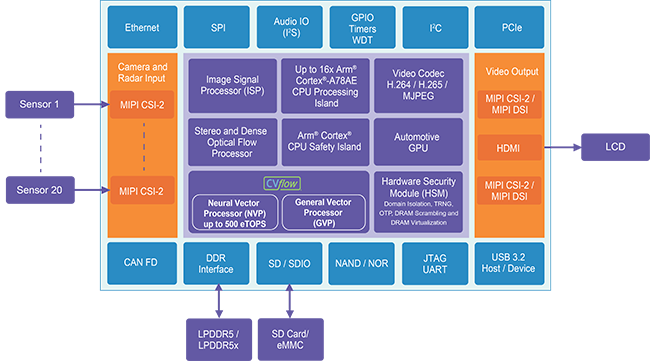
CV3 aims for simpler perception for automakers
Ambarella said its domain controller can provide greater levels of perception in challenging lighting, weather, and driving conditions for ADAS and SAE Level 2 to 4 autonomous vehicles.
The CV3 family’s hardware scalability allows automakers to unify their software stacks across their entire retail portfolios, said the company. Ambarella said it has addressed the rising complexity of automotive software by providing an alternative to the fragmented ADAS SoC offerings from competitors.
In addition, the company said its CV3 can accelerate automakers’ development timelines by allowing the deployment of new features via robust OTA updates.
Ambarella said its new family has multiple options for OEMs and Tier 1 suppliers. They scale from low-power SoCs for regulatory-class, forward-facing cameras all the way to SoCs for Level 4 fully automated driving. This new family also supports both central and zonal architectures.
Domain controller also processes in-vehicle data
In addition to the AD stack, the CV3 can simultaneously process in-cabin sensor data, including driver and occupant monitoring, said Ambarella. As a result, automakers no longer need to develop different software stacks for their entry-level, midrange, and premium vehicles. They can use the unified CVflow platform across all models, saving engineering costs while responding more quickly to market trends, he company said.
CVflow uses a set of mature tools and a robust software development kit (SDK), helping customers to innovate and differentiate their products in the marketplace, said Ambarella.
The company noted that it has also developed an ecosystem of software partners for the platform, working closely with them to port and optimize their applications. Partners include AutoBrains, SenseTime, and StradVision.
The first SoCs in the CV3 family are expected to be available for sampling during the first half of 2022.
Article topics
Email Sign Up

